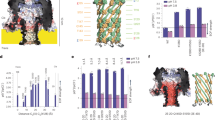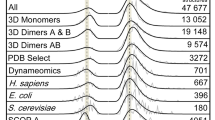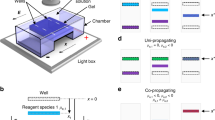Abstract
GEL electrophoresis is widely used in molecular biology to separate DNA molecules according to their sizes. The physical basis of this size separation is, however, poorly understood. Here we report observations of individual, fluorescently stained DNA molecules as they migrate during various kinds of gel electrophoresis. Their movement, under the influence of either a steady electric field or a pulsed-field, is characterized by cycles of elongation and contraction. Initially relaxed coils of DNA lengthen into 'hook-shaped' configurations which temporarily 'hang-up' on obstacles in the gel matrix before sliding off, contracting and entering another cycle. The effects of a new electrophoresis technique, termed 'pulse-oriented electrophoresis", which allows the effective angle of the electric field, and hence the molecular orientation of DNA, to be varied without electrode rearrangement, are also studied. In this case the DNA adopts a 'staircase' configuration showing that the net orientation in a direction is given by the vector sum of the pulses used.
This is a preview of subscription content, access via your institution
Access options
Subscribe to this journal
Receive 51 print issues and online access
$199.00 per year
only $3.90 per issue
Buy this article
- Purchase on Springer Link
- Instant access to full article PDF
Prices may be subject to local taxes which are calculated during checkout
Similar content being viewed by others
References
Yanagida, M. et al. in Applications of Fluorescence in the Biomedical Sciences (eds Taylor, D. L., Waggoner, A. S. Murphy, R. F., Lanni, F. & Birge, R. R.) 321–345 (Alan R. Liss, New York, 1986).
Matsumoto, S., Morikawa, K. & Yanagida, M. J. molec. Biol. 152, 501–516 (1981).
Deutsch, J. M. Phys. Rev. Lett. 59, 1255–1258 (1987).
Deutsch, J. M. Science 240, 922–924 (1988).
Viovy, J. L. Phys. Rev. Lett. 60, 855–858 (1988).
Zimm, B. H. Phys. Rev. Lett. 61, 2965–2968 (1988).
Schwartz, D. C. et al. Cold Spring Harb. Symp. quant. Biol. 47, 189–195 (1983).
Schwartz, D. C. & Cantor, C. R. Cell 37, 67–75 (1984).
Schwartz, D. C. thesis, Columbia Univ. (1985).
Clark, S. M., Lai, E., Birren, B. W. & Hood, L. Science 241, 1203 (1988).
Chou, G., Vollrath, D. & Davis, R. Science 235, 1582–1585 (1986).
Schwartz, D. C., Koval, M. & Hsu, M. manuscript in preparation.
Holzwarth G., McKee, C. B., Steiger, S. & Crater, G., Nucleic Acids Res. 15, 1031–1044 (1987).
Fangman, W. L., Nucleic Acids Res. 5, 653–665 (1978).
Author information
Authors and Affiliations
Rights and permissions
About this article
Cite this article
Schwartz, D., Koval, M. Conformational dynamics of individual DNA molecules during gel electrophoresis. Nature 338, 520–522 (1989). https://doi.org/10.1038/338520a0
Received:
Accepted:
Issue Date:
DOI: https://doi.org/10.1038/338520a0
This article is cited by
-
A viscosity-tunable polymer for DNA separation by microchip electrophoresis
Analytical and Bioanalytical Chemistry (2008)
-
Pulsed-field gel electrophoresis
Nature Protocols (2007)
-
A change in direction
Nature Methods (2006)
-
Nanospheres for DNA separation chips
Nature Biotechnology (2004)
Comments
By submitting a comment you agree to abide by our Terms and Community Guidelines. If you find something abusive or that does not comply with our terms or guidelines please flag it as inappropriate.



